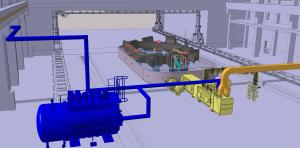D-shaped coils will be tested at 4 K
The ITER superconducting magnets will operate at 4 K (minus 269 °C, a temperature barely above absolute zero) and will carry extremely strong electrical current (up to 68 kA). How will these first-of-kind components behave in such extreme conditions? Part of the question can be answered by testing the magnets at 80 K (minus 194 °C), which is not overly complex or costly and reproduces 90% of the thermal and mechanical constraints a coil will be exposed to during its lifetime. However, as superconductivity is only established when a magnet is brought to 4 K, a test at 80 K says nothing about the electrical behaviour of a coil under operating conditions. Although not planned initially, a window of opportunity has just opened for testing some of the ITER coils at 4 K—a big project within the project.
"Testing at 4 K and at 80 K are completely different operations," explains David Grillot, ITER deputy program manager for plant systems and former leader of the Cryogenics Section. "Considering that a toroidal field coil's mass is in excess of 300 tonnes, the colder test requires considerable infrastructure—a large cryostat, a dedicated power supply, an electrical feeder and associated instrumentation, and an interface with a large refrigerator located inside the cryoplant. It's not comparable at all to testing at 80 K, which is relatively simple and has been done routinely."
All six ITER ring-shaped poloidal field coils and 14 out of 19 D-shaped toroidal field coils will have been tested at the more clement temperature of 80 K before their installation in the ITER machine. Testing at 4 K, however, was only done for the US-procured central solenoid modules. "US ITER demanded that a full-current 4 K factory acceptance test be performed on each central solenoid module before shipment to ITER," says Neil Mitchell, ITER's historical magnet expert. "It definitely made sense as a 4 K test can achieve conditions pretty close to a module's operating point in ITER."
For reasons that have to do with size, shape, the nature of the conductor and with how individual magnets (central solenoid modules or single toroidal field coil) contribute to the total field generated by the coil arrangement (6 stacked modules in one case, 18 coils circling the vacuum vessel in the other), a 4 K test on a toroidal field coil does not completely reproduce the actual conditions the coil will face during the machine's operational phase.
It has, however, an important virtue: it enables the testing of the strategic joints that connect the seven double pancakes that constitute a toroidal field coil. "Making these joints is a hand operation and although we take lots of precautions, deviations are always possible."
Because of the equipment, processes and procedures involved, a 4 K test amounts to a "partial but real-scale commissioning of the tokamak's magnetic system," says David. "A 4 K test is about much more than just testing a coil ... it's about validating a whole infrastructure (the power supply system, the cryogenics, the feeders, the control-command system ...). Along with minimizing risks, this partial commissioning will be like a general rehearsal that will save us a considerable amount of time."
Proceeding to 4 K tests has long been discussed inside ITER. For years, experts and management have confronted their analyses and debated the pros and cons. Confidence in the manufacturing process and other considerations eventually led to the decision not to proceed.
But the mood has changed and "a window of opportunity" has opened. The issues encountered with the vacuum vessel sectors and thermal shield piping and the necessary repairs have interrupted the assembly sequence. Consequently, toroidal field coils will remain accessible for two or three years to come—time enough to build a cold test facility and proceed to the testing of "as many coils as possible."
"Although we are not starting from scratch—coils at JT60-SA and W7-X have been tested at 4 K—the size of the ITER coils and hence the dimensioning of the installation present considerable challenges. Also, we need to finalize the facility in two years when it would normally take twice that time," says David.
But things are moving quickly. The project is presently in its preliminary design phase and the main contracts are already being signed. After a final design review, planned next April, the installation's assembly phase could begin in the first months of 2025 and operation by the end of that year.
"Considering that by that time one or two sector modules will already be installed in the assembly pit, and that a complete cold test at 4 K requires 4 to 6 months, the plan is to test at least one coil from each manufacturer (Mitsubishi and Toshiba in Japan; ASG-SIMIC in Europe)," says David.
The installation and its 350-tonne cryostat (11 m x 22 m—the widest and longest load to travel the ITER Itinerary) will be located in the vacated eastern part of the winding facility used by the European Domestic Agency to fabricate four largest poloidal field coils, and which is still equipped with powerful lifting systems. As a side benefit to building the cold test facility for the toroidal field coils, the size of installation's cryostat will allow for the testing at 4 K of PF1 from Russia, the smallest of the tokamak's six poloidal field coils.




